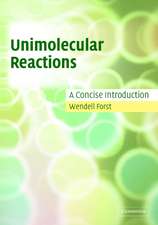Magnetic Interactions in Molecules and Solids: Theoretical Chemistry and Computational Modelling
Autor Coen de Graaf, Ria Broeren Limba Engleză Hardback – 24 sep 2015
The book gives a treatment of magnetic interactions in terms of the phenomenological spin Hamiltonians that have been such powerful tools for chemistry and physics in the past half century, starting from the simple Heisenberg and Ising Hamiltonians and ending with Hamiltonians that include biquadratic, cyclic or anisotropic exchange. On the other hand, it also explains how quantum chemical methods, reaching from simple mean field methods to accurate models that include the effects of electron correlation and spin-orbit coupling, can help to understand the magnetic properties. Connecting the two perspectives is an essential aspect of the book, since it leads to a deeper understanding of the relation between physical phenomena and basic properties. It also makes clear that in many cases one can derive magnetic coupling parameters not only from experiment, but also from accurate ab initio calculations.
The book starts with introducing a selection of basic concepts and tools. Throughout the book the text is interlarded with exercises, stimulating the students to not only read but also verify the assertions and perform (parts of) the derivations by themselves. In addition, each chapter ends with a number of problems that can be used to check whether the material has been understood.
Preț: 402.76 lei
Nou
Puncte Express: 604
Preț estimativ în valută:
77.09€ • 83.77$ • 64.80£
77.09€ • 83.77$ • 64.80£
Carte disponibilă
Livrare economică 31 martie-14 aprilie
Preluare comenzi: 021 569.72.76
Specificații
ISBN-13: 9783319229508
ISBN-10: 3319229508
Pagini: 246
Ilustrații: XVI, 246 p. 75 illus., 32 illus. in color.
Dimensiuni: 155 x 235 x 20 mm
Greutate: 0.76 kg
Ediția:1st ed. 2015
Editura: Springer International Publishing
Colecția Springer
Seria Theoretical Chemistry and Computational Modelling
Locul publicării:Cham, Switzerland
ISBN-10: 3319229508
Pagini: 246
Ilustrații: XVI, 246 p. 75 illus., 32 illus. in color.
Dimensiuni: 155 x 235 x 20 mm
Greutate: 0.76 kg
Ediția:1st ed. 2015
Editura: Springer International Publishing
Colecția Springer
Seria Theoretical Chemistry and Computational Modelling
Locul publicării:Cham, Switzerland
Public țintă
ResearchCuprins
1. Basic Concepts.- 2. One Magnetic Center.- 3. Two (or more) Magnetic Centers.- 4. From Orbital Models to Accurate Predictions.- 5. Towards a Quantitative Understanding.- 6. Magnetism and Conduction.
Notă biografică
Prof. Dr. Ria Broer, Group Leader, Department of Theoretical Chemistry, Zernike Institute for Advanced Materials , University of Groningen, The Netherlands.
Prof.Dr. Coen de Graaf, Department of Physical and Inorganic Chemistry,Universtitat Rovira i Virgili and ICREA (Catalan Institution for Research and Advanced Studies), Spain. Also Honorary Professor, University of Groningen, The Netherlands.
Prof.Dr. Coen de Graaf, Department of Physical and Inorganic Chemistry,Universtitat Rovira i Virgili and ICREA (Catalan Institution for Research and Advanced Studies), Spain. Also Honorary Professor, University of Groningen, The Netherlands.
Textul de pe ultima copertă
This textbook is the second volume in the Theoretical Chemistry and Computational Modeling series and aims to explain the theoretical basis of magnetic interactions at a level that will be useful for master students in physical, inorganic and organic chemistry.
The book gives a treatment of magnetic interactions in terms of the phenomenological spin Hamiltonians that have been such powerful tools for chemistry and physics in the past half century, starting from the simple Heisenberg and Ising Hamiltonians and ending with Hamiltonians that include biquadratic, cyclic or anisotropic exchange. On the other hand, it also explains how quantum chemical methods, reaching from simple mean field methods to accurate models that include the effects of electron correlation and spin-orbit coupling, can help to understand the magnetic properties. Connecting the two perspectives is an essential aspect of the book, since it leads to a deeper understanding of the relation between physical phenomena and basic properties. It also makes clear that in many cases one can derive magnetic coupling parameters not only from experiment, but also from accurate ab initio calculations.
The book starts with introducing a selection of basic concepts and tools. Throughout the book the text is interlarded with exercises, stimulating the students to not only read but also verify the assertions and perform (parts of) the derivations by themselves. In addition, each chapter ends with a number of problems that can be used to check whether the material has been understood.
The book gives a treatment of magnetic interactions in terms of the phenomenological spin Hamiltonians that have been such powerful tools for chemistry and physics in the past half century, starting from the simple Heisenberg and Ising Hamiltonians and ending with Hamiltonians that include biquadratic, cyclic or anisotropic exchange. On the other hand, it also explains how quantum chemical methods, reaching from simple mean field methods to accurate models that include the effects of electron correlation and spin-orbit coupling, can help to understand the magnetic properties. Connecting the two perspectives is an essential aspect of the book, since it leads to a deeper understanding of the relation between physical phenomena and basic properties. It also makes clear that in many cases one can derive magnetic coupling parameters not only from experiment, but also from accurate ab initio calculations.
The book starts with introducing a selection of basic concepts and tools. Throughout the book the text is interlarded with exercises, stimulating the students to not only read but also verify the assertions and perform (parts of) the derivations by themselves. In addition, each chapter ends with a number of problems that can be used to check whether the material has been understood.
Caracteristici
Targeted at Masters students in Chemistry Designed as a textbook for those studying magnetic interactions in molecules and solids and magnetic materials Provides a clear overview of the basics Well illustrated with colour figures Includes questions and solutions Includes supplementary material: sn.pub/extras













